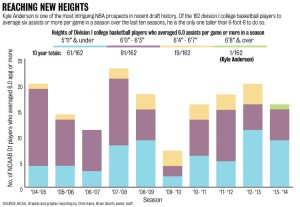This post was updated on June 27 at 7:23 p.m.
The names continued to be called, down the pecking order of the NBA draft’s first round. Tyler Ennis. Shabazz Napier. C.J. Wilcox.
Kyle Anderson, meanwhile, kept waiting. He had been one of the most polarizing prospects in the draft, his stock ranging anywhere from the tail end of the lottery to the late first round. Thursday night, his selection came at the very end of that spectrum.
With the No. 30 and last pick of the first round the defending NBA champion San Antonio Spurs took the former Bruin basketball guard/forward.
“He just knows how to play. He’s the best passer in this draft,” said ESPN college basketball analyst Jay Bilas after Anderson’s selection.
It’s the mismatch in size and skill set that has puzzled many: a point guard’s talents in a 6-foot-9-inch frame.
This past season, along with his 14.8 points per game and 8.8 rebounds per game, Anderson averaged 6.5 assists per game. In the past ten years, of the 162 NCAA division I college basketball players who averaged six or more assists per game in a season, Anderson was the only player taller than 6-foot-8-inches to do so.
“He’s just so unique. … He sees the game like a point guard, and the fact that he’s 6-feet-9 makes it more difficult to play against him,” said UCLA men’s basketball director of operations Tyus Edney, a former Bruin who played four seasons in the NBA.
When coach Steve Alford arrived at UCLA this past season, he moved Anderson from forward to his natural position: point guard.
“With him you’ve got someone with a 7-foot-3 wingspan, somebody that can play the point, and has … as good a basketball IQ as (anybody that) I have coached,” Alford said in a teleconference call with the media Friday morning. “Kyle understands how to play the game.”
Anderson rewarded his coach’s faith, flourishing in his new role. He earned All-Pac-12 honors, led the Bruins to a Pac-12 tournament title and an NCAA Sweet 16 appearance.
“He did everything for us … and just was a stabilizer for us,” Edney said.
But how Anderson’s game will translate to the NBA is up in the air.
Hindered by slow foot speed, Anderson seems to be a liability on defense. Smaller, quicker guards can easily blow by him on the perimeter. He could struggle to guard NBA small forwards, his projected future position, lacking the strength to defend the post.
“I think (defense is) something that’s he’s going to have to work on,” Edney said. “I think the NBA is obviously a lot more one-on-one and he has to get stronger, quicker and really focus on that end of the floor.”
For Anderson, maybe the fall down the first round draft board could be his lucky draw.
In San Antonio, small forward Boris Diaw is entering free agency. With Anderson and Diaw playing similar styles, Anderson will likely serve as his replacement and could slip into the bench rotation for the defending NBA champions as early as next season.
As a team, the Spurs’ offensive system is based on sharing the ball. It just may be tailor-made for Anderson’s unselfish, playmaking nature.
“I can tell from the way they play, their half court system is very good and they all share the ball really well … everybody gets everybody involved. And I think that’s one of my best attributes coming into this league,” Anderson said in a teleconference call with media members in Texas. “So watching them play a bunch of times, I always thought I fit in with the Spurs really well.”
Scouting Report: Kyle Anderson – How he performed at UCLA, and will his game translate to the NBA?
Strengths:
· He has a tremendous basketball IQ. He carves up opponents with his ability to read defenses and anticipate plays and cuts ahead of time, allowing him to create scoring opportunities for his teammates. Playmaking is Anderson’s natural instinct, and will be his primary asset in the NBA.
· Length, length and more length. He has a nearly 7-foot-3-inch wingspan, allowing him to shoot over defenses and drive by defenders to get into the lane on offense. On defense, he can alter shots and interrupt passing lanes. He finished third in the Pac-12 in steals last season.
· Though he’s not a great athlete, he uses his height, length and natural rebounding instincts to be a force on the boards. He led the Pac-12 in defensive rebounds last season, and he should continue to rebound well at the next level.
Weaknesses:
· Appropriately nicknamed “Slow Mo” for his slow foot speed, Anderson’s lack of mobility will likely plague him in the NBA. He doesn’t appear quick enough to guard smaller, faster players, and scouts have pegged him as a small forward at the next level. Yet questions remain if he can even guard that position. Is he strong enough? Athletic enough? Perhaps the real question is will Anderson’s offensive talents overshadow his defensive deficiencies enough to see significant court time?
· Anderson succeeded in college despite a lack of athleticism and explosiveness. As he jumps to the NBA, it remains to be seen how his game will translate against taller, more athletic defenders – something he didn’t have to contend with much at the college level. They’ll likely force him into tougher shots and more forced passes, but expect Anderson to adjust behind his natural basketball instincts.
· He can be turnover-prone. As strong of a playmaker Anderson is, at times he tries too hard to make plays, forcing passes into the defense. And he has a high, sometimes loose dribble, causing him to be pick pocketed easier than most.

